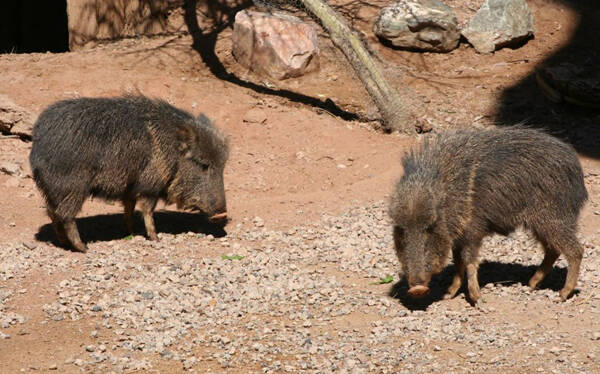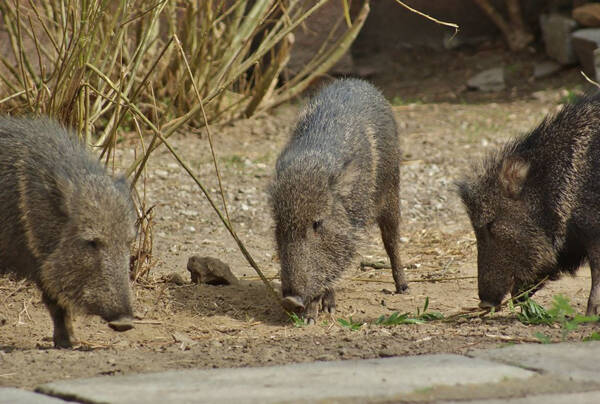Catagonus wagneri
IUCN
LCBasic Information
Scientific classification
- name:Catagonus wagneri
- Scientific Name:Catagonus wagneri,Chacoan Peccary,Tagua
- Outline:Ungulata
- Family:Artiodactyla Peccary S.Peccary
Vital signs
- length:96-117cm
- Weight:29.5-40kg
- lifetime:9-18years
Feature
Has many characteristics of a pig
Distribution and Habitat
The steppe peccary is endemic to the arid regions of western Paraguay, southeastern Bolivia, and northern Argentina. The total geographical range is about 140,000 km2. In Paraguay, the species originally occurs in all areas of the Gran Chaco. In Argentina it occurs in the Chaco, Formosa, Salta, and Santiago del Estero provinces. In Bolivia it persists in the dry Chaco region in the provinces of Chuquisaca, Santa Cruz, and Tarija.
The steppe peccary inhabits hot and arid jungles. The 140,000 km2 Grand Chaco Valley is dominated by succulents and thorny plants, with only a few large trees. Their sinuses are adapted to living in an arid and dusty environment. Their thin feet allow them to walk among the thorny plants.
Appearance
The steppe peccary is 52–69 cm tall at the shoulder, with a head-body length of 96–117 cm; it weighs 29.5–40 kg. It is the largest of the three species of peccary in the family Peccary. It is an ungulate, with identical sexes. It has many "pig" characteristics. The head is very large, with a snout that tapers to a cartilaginous snout. Its snout is rough, and its snout is tough and well-structured. Its ears, snout, and tail are long, and its legs are also long, adapted for running, with only the forelimbs having dew claws, and the hind feet having three toes.
This species has prominent dorsal glands like the other two species of peccary. It also has a large scent gland at the rear end of the back, located about 15 cm above the base of the tail. The gland consists of a group of subcutaneous glands and surrounding tubular glands. It appears as a raised area of skin, about 5–7 cm along the midline of the back. The gland produces a milky white substance used for marking in te
Details
The Chacoan Peccary (Catagonus wagneri) has no subspecies. When it was first discovered, there were only some fossils of the Chacoan Peccary and it was thought to be extinct. It was not until 1975 that they were found alive in the Grand Chaco Plain. The indigenous people are very familiar with them.

The steppe peccary is larger and heavier than the other two species of the family Peccary. It also differs in having a longer back bone, a longer muzzle, a proportionally larger head, and longer ears, tail, and legs. The skull differs from other wild boar species in that their muzzle, nasal cavity, and sinuses are extremely developed. Similar to the other two species, the steppe peccary does not show significant sexual dimorphism. Males are slightly heavier than females, except when pregnant.
Like the collared peccary, the steppe peccary has a territory based on a convex polygon of approximately 1,100 hectares, with the core area of the Paraguayan steppe peccary being approximately 600 hectares. Density estimates range from less than 1 per square kilometer to as high as 9.2 per square kilometer. A study conducted in the Paraguayan steppe peccary range yielded a density estimate of 0.43 per square kilometer. In the Argentine steppe peccary range, the density was 0.17 per square kilometer between hunted sites and 0.44 per square kilometer between non-hunted sites.
The herd size of the steppe peccary ranges from 1-9, with an average of 4.5. However, in hunting areas, the average group size is smaller, ranging from 1-4. They often travel in groups of up to 10. They are diurnal animals, most active in the early morning, especially in the morning, active throughout the day, resting in the shade of trees and bushes at noon, and inactive at dusk. The group will migrate in a circle, returning to the original place in about 42 days to monitor the territory and show ownership of their area.
The steppe peccary has a well-developed long-range vision and sense of smell. As a defensive strategy, the group members will form a wall to protect themselves, but they are easy targets for hunting. Although the species is not particularly timid or wary, when startled they will flee quickly, raising the long hair on their backs and spraying secretions from dorsal glands, presumably to keep the group together by scent. They secrete a milky and smelly substance, which is secreted from glands on their backs and smeared on trees as marks, or dispersed by rubbing against the surroundings. These secretions are rubbed against group members and also used as territorial markings. Although they often roll in the mud, they defecate in specific locations. These social mammals communicate through a variety of sounds, communicating with different calls, including grunts and teeth chattering. Although individuals occasionally display aggressive behavior, sometimes with behaviors such as ramming and biting, the species is not as aggressive as other species.

The arid habitats of the Gran Chaco region provide a very solid vegetation base for the prairie peccary. These species are dominated by various cacti, including species of the genus Tubulestyla and Opuntia discolor, which are the main food of the white-lipped peccary. The prairie peccary uses its hard snout to roll the cactus to the ground and grind off the spines. They can also use their teeth to extract thorns and spit them out. The kidneys of the steppe peccary are specialized for breaking down the acid in cacti. The two-chambered stomach is also well suited for digesting hard-to-digest, rough foods like cacti. They occasionally eat roots of bromeliads, as well as pods of acacias and fallen cactus flowers. This wild boar seeks out mineral-rich soils formed by anthills and construction sites, and seeks out salt licks to absorb essential minerals such as calcium, magnesium, and chlorine from salt. They will also occasionally eat carrion and may even prey on small mammals.
The steppe peccary is found in South America and is very vulnerable to human activity. Populations have also declined due to loss of habitat and fragmentation. There have also been effects from hunting and unknown diseases. The species is fragmented throughout its limited geographic range and is declining in numbers. The species has disappeared from much of the Argentine Chaco and has lost about 40% of its original range. It has also declined in Bolivia and eastern Paraguay. The total number of the species is unknown, but it was estimated that 5,000 individuals survived in Paraguay in the early 1990s. Estimates of density and remaining habitat in Argentina put the number at 3,200 in 2002. This was before large-scale deforestation in the region began in 2003. Another study conducted in Argentina found that the steppe peccary was the rarest of the three wild boar species in the region and may be the most vulnerable to human disturbance.
The decline in the range and numbers of the steppe peccary is probably due to a number of factors. These factors include human hunting, habitat destruction and disease. Predation by big cats is also a cause. Of these, hunting pressure has the greatest negative impact. In all three countries, all game species in the Chaco region, wherever they occur, even in national parks and reserves, are heavily hunted. The steppe peccary constitutes one of the most important sources of previously abundant bushmeat. The skin of the steppe peccary is thinner and less valuable than the skins of other wild boars. For example, in 1988 fur buyers in Paraguay purchased the skins of the steppe peccary from settlers for about $0.5 each. However, they are still hunted and traded commercially.
Listed in the IUCN Red List of Threatened Species in 2011, ver 3.1 - Endangered (EN).
Protect wild animals and stop eating game.
Maintaining ecological balance is everyone's responsibility!








